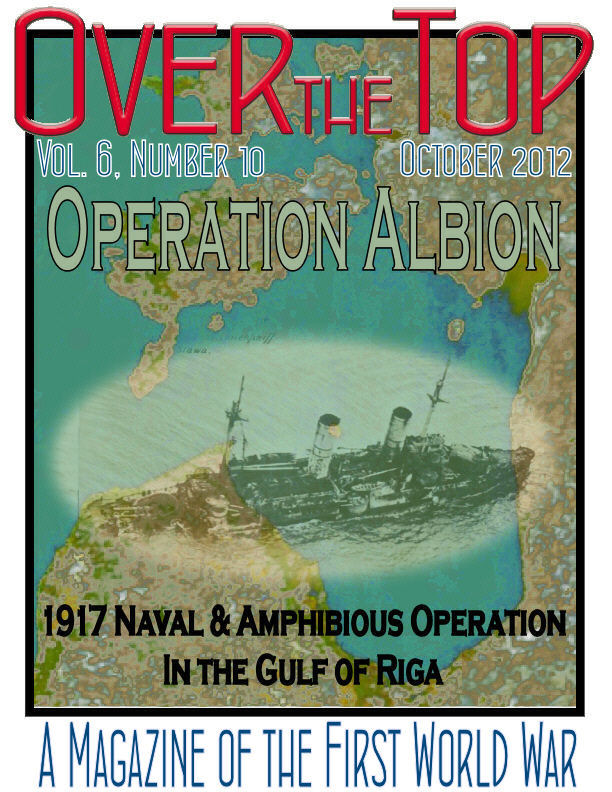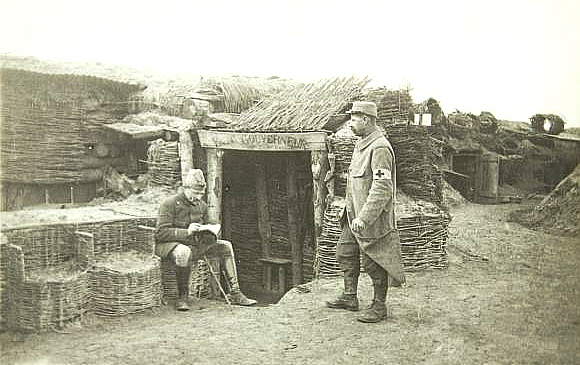


October 1912
Resounding Bulgarian Victory at Kirk Kilisse Opens
First Balkan War
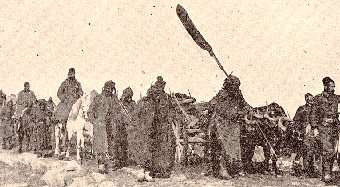
Defeated Ottoman Troops Retreating
|
Immediately after declaring war on 17 October Bulgarian forces invaded Ottoman territory in Thrace. After turning back an ill-conceived spoiling offensive, the Bulgarians mounted a major attack before Turkish reinforcements could arrive from Anatolia. The ensuing fight on 22-24 October is known as the Battle of Kirk Kilisse or the Battle of Lozengrad. It involved a successful flanking operation against a 36-mile front stretching easterly from Lozengrad to Adrianople.
During the battles around Lozengrad, Bulgarian infantry were supported by artillery and often attacked in poor light, at dawn, or even at night. The Ottomans were unable to withstand the Bulgarian charges, which were supported by artillery and machine gun fire, and by 24 October were in an ill-disciplined retreat all along the line between Adrianople and Lozengrad. Six days into the war the Bulgarians had won a major victory and the Ottoman forces had suffered a strategic and demoralizing defeat.
|
TRENCH REPORT: I want to give a brief thank-you to all the readers of the Trip-Wire, who dropped by to say hi at recent meeting at Quantico. Thanks a ton from the editorial team. We will include photos from the big event over the next several issues. MH
News from the World War One Historical Association
Click on Title or Icon to Access
|
Announcement of 2013-2014 WW1HA Officers
President Steve Suddaby has announced that the WW1HA Board of Directors elected officers for the next two-year term at their meeting on September 6th. Starting on October 8th, the Association's officers will be: President, George Thompson; Vice President, Dennis Cross; Treasurer, David Cooper; and Secretary, Steve Suddaby.
Nominations for the WW1HA Board of Directors
WW1HA is soliciting nominations for members of the Board of Directors for the 2013-2015 terms. As a practical matter, people generally nominate themselves rather than others. (If you nominate someone else, please ask their permission first.) If you wish to make a nomination or have questions about working on the board of directors, please send an email to Steve Suddaby at suddaby@cox.net .
The WW1HA National Seminar Was a Big Success.
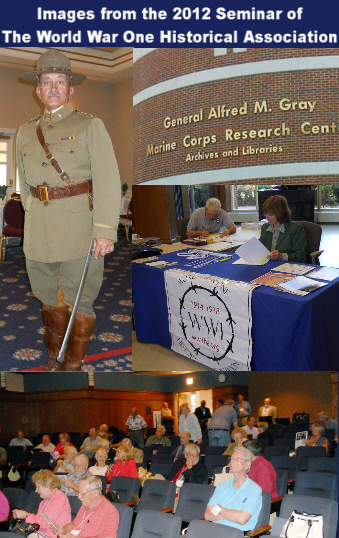 The organizers of the seminar held at the
USMC University Gen. Alfred Gray Research Center did a great job with the venue and program. Dana Lombardy and Carol Vandenbrul manned the welcome desk. Well over 100 were in attendance. Even General Pershing put in an appearance.
The organizers of the seminar held at the
USMC University Gen. Alfred Gray Research Center did a great job with the venue and program. Dana Lombardy and Carol Vandenbrul manned the welcome desk. Well over 100 were in attendance. Even General Pershing put in an appearance.
|
|
Thanks to the U.S. Marine Corps University, Quantico
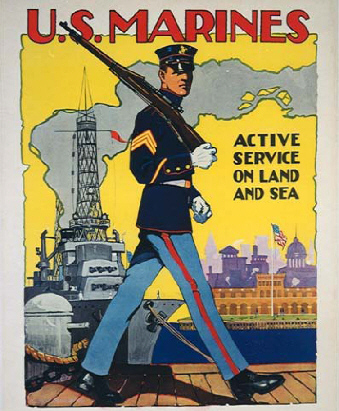
You Were Wonderful Hosts for our 2012 National Seminar
This Month's Internet Feature
World War I Postcards
One of the Great War's most popular collectibles, the postcard is also a source for unique images from the period.
Great War Postcards
At FirstWorldWar.com
Romantic Postcards
Comic Postcards
Propaganda Postcards
Sarah Phillips Collection with Commentary

During WWI, Austria-Hungary had an almost unbelievable 2,770,000 prisoners of war, of whom 453,000 (16%+) died while incarcerated. The total captives approximately matched the number for the much larger Russian army, but their rate of fatalities was four times the Russian.
Source: POWs and the Great War: Captivity on the Eastern Front by Alon Rachamimov

Paris,
11 October 1917
At the end of the party there was an air raid warning. I shan't tell you whether the planes flew to the right or left of Cassiopeia, I only know that I caught cold because I went out on the balcony to see this wonderful Apocalypse with the soaring and descending aeroplanes seeming to complement or eclipse. . . .it was so marvelous.
Marcel Proust,
Letter
Next Month
10th Anniversary Issue
|
|
|
Page Two
|
|
|

|
|
From a Sister Organization to Our Readers & Members
WFA President's Conference
Click on Image for Registration Information
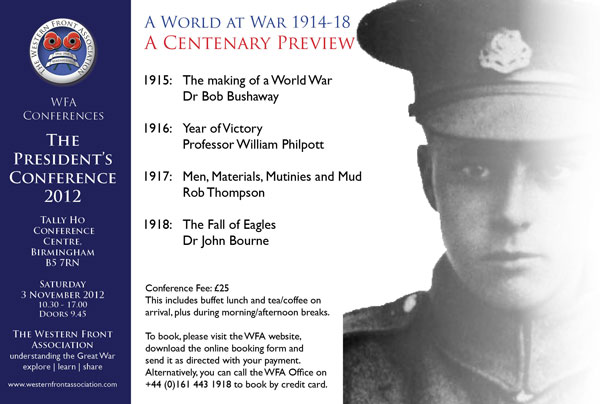
|
|
My World War I Expeditions for Valor Tours, Ltd.

Click on Image to Send Email
|
World War I Headlines
in the 21st Century
|
|
|
Subscribe to Our Online Magazine
|
|

|
|
Page Three
|
|
|
Special Feature
Before Downton Abbey
|
There was a lot of excitement in the World War One community last season as the Crawley family and their servants faced the challenges of the Great War. The next season of Downton Abbey, in which Lord Grantham, his extended family and staff, confront the turmoil of the postwar period, is now showing in the UK and will arrive on PBS in the States in January. Before then, however, we thought you might want to consider renting or downloading some earlier dramatic series that had extended segments covering the events of 1914-1918. Below is our first installment of three that the Trip-Wire staff have just revisited. Next month, we will feature three of Masterpiece Theatre's classic series with WWI connections.

|
Fall of Eagles
First Shown on the BBC in 1974
This absorbing 13-episode series captures the broad sweep of changes in three empires, Russian, Austro-Hungarian, and German, from the Revolution of 1848 to the abdication of Kaiser Wilhelm in November 1918. Its dramatic effectiveness, though, lies not in large scale battlefield scenes but in its character development, revealed in the dialogue, actions, and habits of the many principals. The decline and fall of these empires is revealed in nuanced detail, as viewers experience the increasing remoteness and disconnection of rulers from their people and their total inability to see, let alone embrace, change. They fossilize before our very eyes.
Episodes 10 to 13 deal specifically with World War I, each from a different perspective. "Indian Summer of An Emperor" (10) focuses on Franz Joseph, his relationship with Franz Ferdinand, and the assassinations in Sarajevo. "Tell the King the Sky Is Falling" (11) covers mobilization and the outbreak of war, with an emphasis on Russia. "The Secret War"(12) dramatizes Lenin's life in Switzerland and the machinations involved in bringing him back to Russia via private train through Germany. The last episode, "End Game" (13), looks at Germany in the last months of the war, up to Kaiser Wilhelm's abdication and arrival in Holland.
Although the series is nearly forty years old it has held up extremely well because of the wonderful script, emphasis on character development and interaction, and amazing performances. My five favorites among the huge cast are Barry Foster as Kaiser Wilhelm, Curt Jurgens as Bismarck, Gemma Jones as Princess Vicky, Charles Kay as Tsar Nicholas, and Patrick Stewart as Lenin. Diane Rooney
|
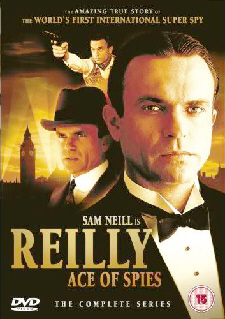
|
Reilly, Ace of Spies
First Shown on ITV in 1983
A superb team of writers and actors was assembled to depict the career of the man who is considered the model for James Bond, Russian-born Sigmund Rosenblum, who later assumed the Irish identity of Sidney Reilly. (This, as depicted in the series, was to annoy his British handlers.) His portrayal of Reilly made New Zealander Sam Neill a household name in America. The World War One content of the 12-episode series is on the periphery of the battlefields—Reilly got everywhere, knew everyone, but avoided the trenches.
By 1912 Sidney Reilly had, among other assignments for Great Britain, investigated Russian oil interests in the borderlands of Persia (presumably to forward fuel possibilities for Admiral Fisher's dreadnoughts); subverted Russian capabilities (limited though they were) in Port Arthur on the eve of the Russo-Japanese War; and furthered British naval priorities by allegedly representing the German shipbuilding company Blohm & Voss in St. Petersburg when Russia was seeking to rebuild her northern fleet after the naval disaster in the war with Japan. Reilly's work obtaining details of those ships and their armaments for the British may well have been useful for the Admiralty from 1914-1918. In several episodes Reilly crosses swords with arms dealer Basil Zaharoff, wickedly portrayed by Leo McKern.
Early in the war, Reilly, himself, turned up as an arms dealer based in New York. As for his actual service during the Great War, reports are varied and murky, as well they would be with him. Reportedly, among other exploits, he parachuted into Germany and posed as a German officer, to what avail is not reported. His rank was supposedly captain in the Royal Canadian Air Corps. The World War One and concluding episodes focus on his effort to undermine the Bolshevik Revolution. The portrayals of David Burke as Stalin and Tom Bell as Dzerzhinsky (head of the Cheka) are highlights of the series. In the end the pair lure Reilly back to Russia and execute him in 1925. This series is one for your library. All the parts are perfectly cast (look for Bill Nighy, for example, as a noble but doomed amateur British spy in the German shipyards) and the dialogue and narrative remain engrossing after many viewings. No wonder Ian Fleming couldn't resist Sidney Reilly—no one can. Kimball Worcester
|
|
Once an Eagle
First Shown on NBC in 1976
This nine-hour epic is based on Anton Meyer's fine novel of the same title that covers the entire career of a U.S. Army officer starting with his service in the First World War. Comparisons, however, can stop with these minimal facts. Except for well-chosen lead Sam Elliott and the always-reliable Glenn Ford, the entire cast of the TV series seems to have studied their craft at the "Overacting School of Dramatics." The military content is dismaying, too. Uniforms, insignia, soldiers' language, haircuts, the look of the battlefields, and much else are all out of kilter. The battle segments give no insights or details on the actual operations of the AEF.
Skip the TV series, but read the book. It's got a most admirable and interesting protagonist and conveys enduring lessons on leadership.
MH
|
|
Kaiser Wilhelm II Inspecting His Troops
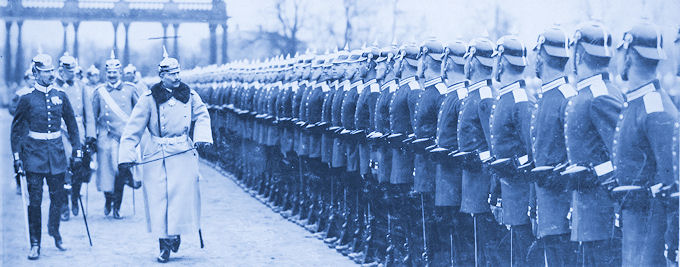
In this prewar photo that perfectly captures the Kaiser's militaristic enthusiasms, he is inspecting a Guards detachment, probably at Potsdam. As Wilhelm marches past, each of the soldier's heads snaps forward from the "eyes-right" position. Like their British equivalents, the "Old Contemptibles," most of these men were probably killed or wounded in the coming war.
In November 1908, British foreign minister Sir Edward Grey perfectly captured in words this same disposition of Germany's ruler and foresaw its consequences:
[The Kaiser] is like a battleship with steam up and screws going, but with no rudder, and he will run into something some day and cause a catastrophe. He has the strongest army in the world and the Germans don't like being laughed at and are looking for somebody on whom to vent their temper and use their strength...Now it is 38 years since Germany had her last war, and she is very strong and very restless, like a person whose boots are too small for him. I don't think there will be war at present, but it will be difficult to keep the peace of Europe for another five years.
|
|
|
 |
Preview of the Next Issue of the
Journal of the
World War One Historical Association
Centennial Retrospective on the
Year 1912
|
You probably know that the same team that publishes the St. Mihiel Trip-Wire, also—each quarter—produces a 48-page, illustrated magazine, The Journal of the World War One Historical Association. We are quite excited about our next issue of The Journal, because it focuses primarily on 1912, a key year in the run-up to the war. It begins with an overview of the politics and diplomacy of the year by our regular contributor Len Shurtleff, followed by four major and four shorter articles on the year 1912, when unbeknownst to the general public, the run up to the Great War had begun. We also are including a reflection on the war's civilians and noncombatants in this issue, besides our regular sections. Below are four major works by contributors to this issue that we would like to recommend to you for your personal libraries.
To receive The Journal, you need to be a member of the association. An annual subscription comes with your dues. Just visit the Association's website by clicking here to enlist and begin receiving The Journal.
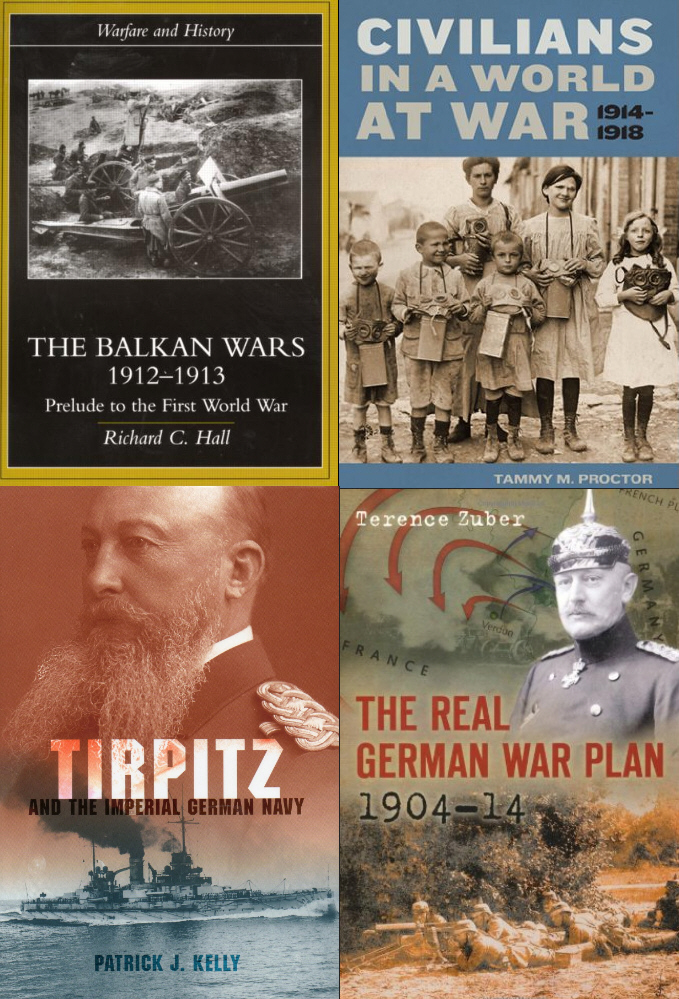
|
|
|










